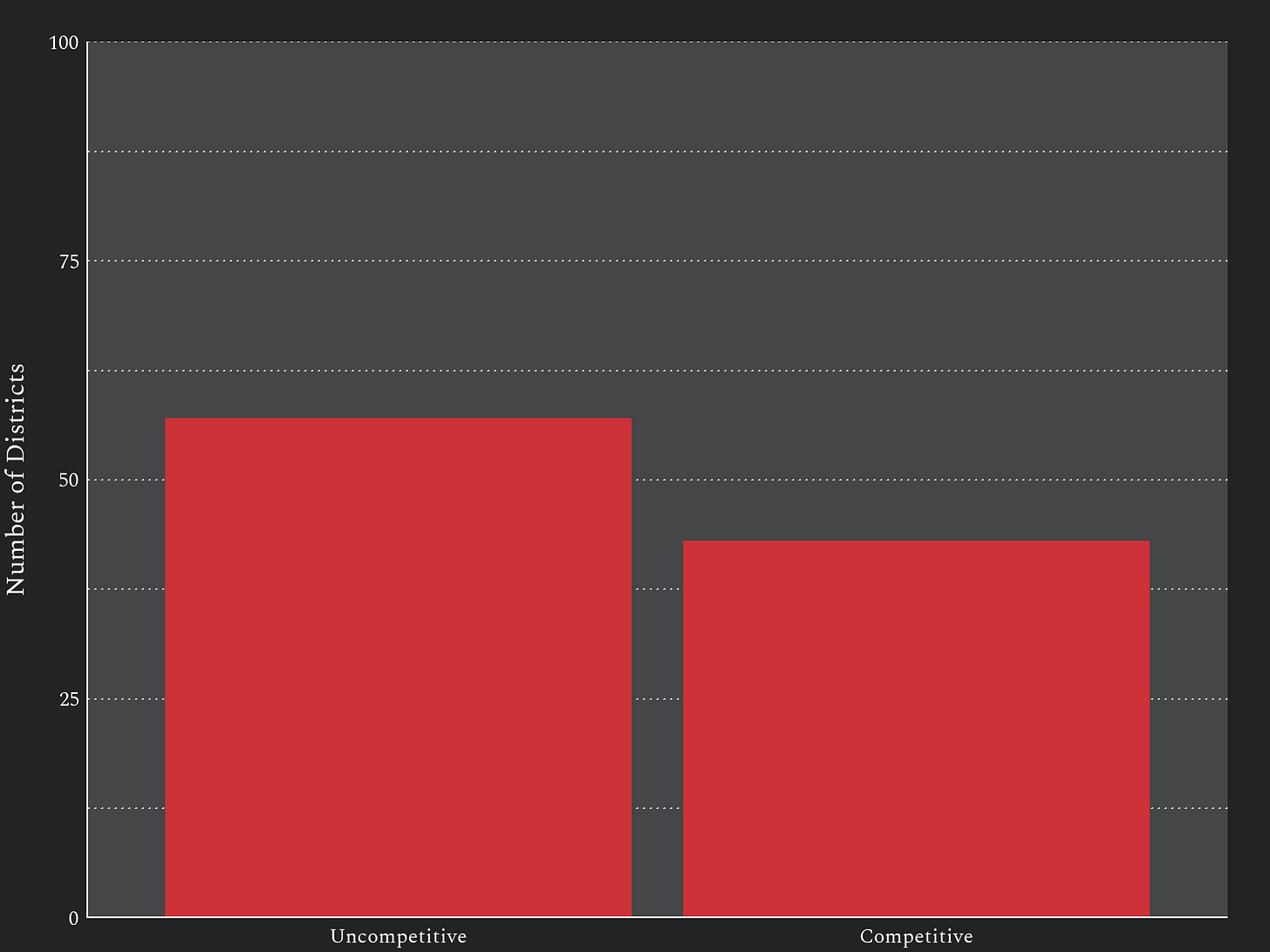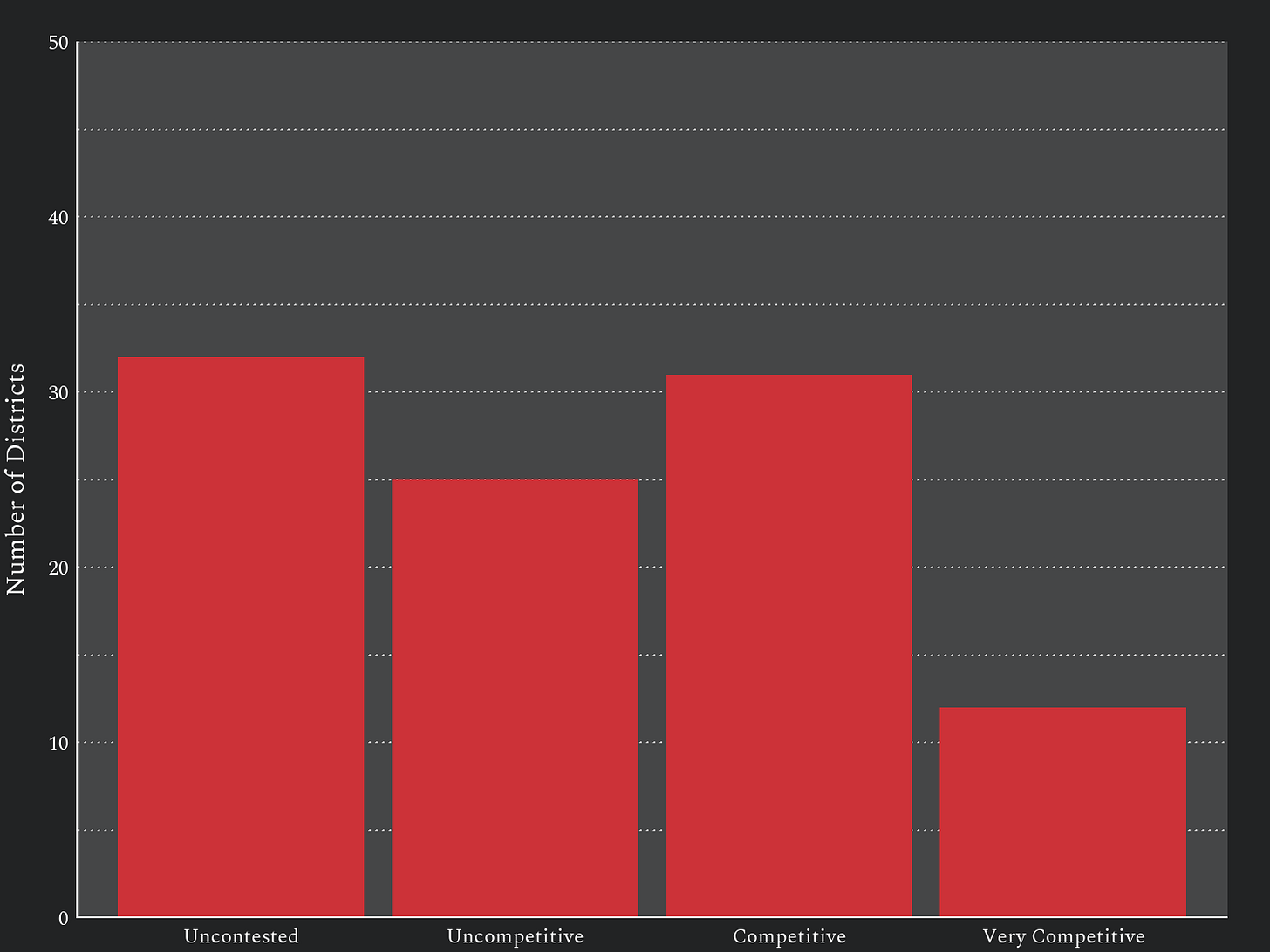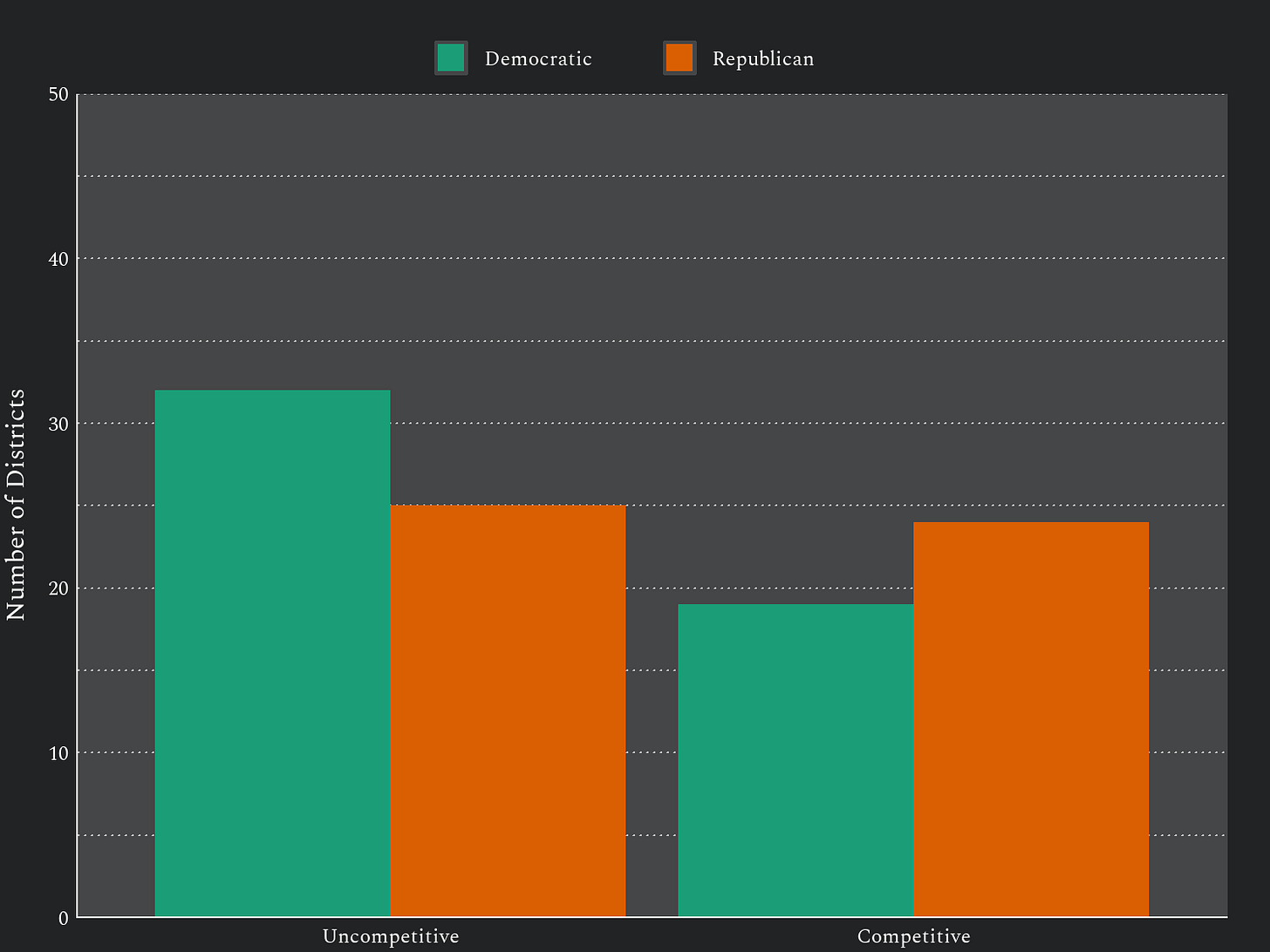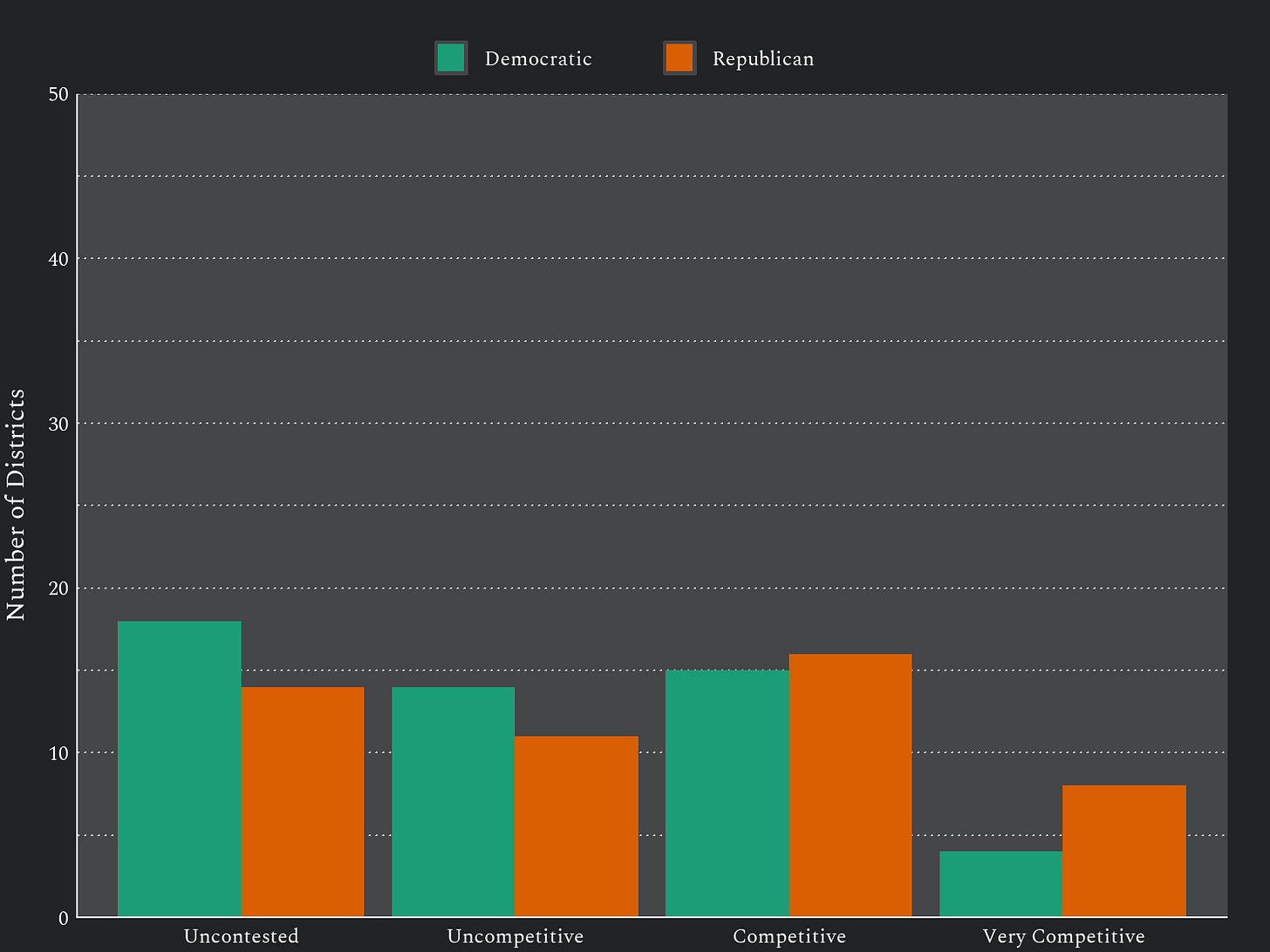Democrats Have Advantage Going into 2025 Virginia House of Delegates Election
Democrats hold more uncompetitive districts than Republicans, and multiple districts with Republican incumbents voted for Harris in 2024.
Introduction
The 2024 General Election of the United States did not go well for Democrats. This has been covered elsewhere, so I won’t repeat the effluence of summary statistics here.
More recently, a Quinnipiac University poll found that the public currently has the least favorable opinion of the Democratic Party it has had since the poll began in 2008.
Virginia is unusual in that its general elections occur in odd-numbered years, and Virginia elects its Governor in the year immediately following the election of the U.S. President.
Because of this timing and because Virginia’s elections are so close, analysts sometimes look to Virginia as a bellwether of trends in American electoral politics.
Many in the rest of the United States have forgotten that Virginia is a swing state. This is likely because Virginia hasn’t elected a Republican to the U.S. Senate since 2002 or voted for a Republican for President since 2004.
However, the electoral balance is very close within the Commonwealth of Virginia. The Virginia General Assembly comprises the 40-seat Senate and the 100-seat House of Delegates. Democrats currently have a 21-to-19 majority in the Senate and a 51-to-49 majority in the House of Delegates.

Virginia elects its Senate every 4 years and its House of Delegates every 2 years. All seats are up for election simultaneously whenever there is a general election. The last election of the Senate of Virginia was in 2023, so the next one won’t be until 2027. However, the House of Delegates is up for election this year, as it is every general election.
Virginia will also elect a new Governor in 2025. Currently, the Governor of Virginia is Glenn Youngkin, a Republican. However, a Governor of Virginia cannot serve more than one term, so Youngkin cannot run for re-election in 2025. (A follow-up article will cover the gubernatorial election, which will also be very close, while this article focuses on the House of Delegates.)
Members of the Virginia General Assembly are elected by district. Thus, Senate districts are more extensive than delegate districts.
Virginia is supposed to draw new electoral districts after every U.S. Census and so should have new districts for each decade because the Census occurs decennially (in 1990, 2000, 2010, 2020, etc.). However, redistricting has become very contentious. Therefore, the 2021 General Election used the old (2010 Census) districts, and the new (2020 Census) districts weren’t used until the 2023 General Election.
Therefore, Virginia went into the 2023 General Election without a history of how the various districts would vote. In the 2025 General Election, we have a better idea of the balance of power in the Commonwealth.
Changes in Party from 2011 to 2021
Because the 2011, 2013, 2015, 2017, 2019, and 2021 general elections used a different districting scheme (2010 Census), the results do not directly apply to the new districting scheme (2020 Census). However, the earlier results help us understand what constitutes a competitive district.
I took data from the Virginia Department of Elections on election results since 2011. Of the 500 elections for delegates from the general elections of 2013 to 2021, a district elected a delegate from one party after having previously elected a delegate from a different party in the previous general election 33 times.1
Thus, once delegate districts are established, they tend to be stable. Districts only switched from Democratic to Republican or Republican to Democratic 33 times out of 500 opportunities (6.6% of the time).
There were also strong trends by year in party changes during the 2013 to 2021 time frame. Generally, there was a shift from Republicans to Democrats in 2015, 2017, and 2019, and then there was a shift from Democrats to Republicans in 2021. Only one party change went against these trends: District 2 (2010 Census) elected a Republican delegate in 2015 after having elected a Democrat in 2013. All other party changes followed these trends. Thus, changes in delegates’ parties tend to go exclusively in one direction.
Among those 33 party changes, 8 involved a winning candidate whose party had no candidates running in the previous general election. Therefore, these cases are not insightful for this analysis.
Of the remaining 25 party changes, the largest margin of victory in the preceding general election was 26.8 percentage points, which occurred when District 42 (2010 Census) elected a Democrat as delegate in 2017 after having previously elected a Republican delegate in 2015. The average margin of victory in a preceding election before a party change was 8.3 percentage points.
Classification of District Competitiveness Based on 2023 Results
I used these as thresholds for what constitutes a competitive delegate district. I classified any delegate district with a margin of victory in its 2023 general election of less than 26.8 percentage points as “competitive.” I also classified any with a margin of victory of less than 8.3 percentage points as “very competitive.”
Based on the 2023 General Election results, most (57) of Virginia’s delegate districts are uncompetitive.
Of the 57 uncompetitive districts, 32 had uncontested elections for delegate in 2023, in which only one candidate ran. In another 25 uncompetitive districts, the margin of victory was greater than 26.8 percentage points. Of the 43 competitive districts, 12 are very competitive, and 31 are simply competitive.
Democrats appear to be more secure going into the 2025 General Election. Of their 51-seat majority in the House of Delegates, 32 delegates (~63%) are from uncompetitive districts. For Republicans, 25 of their 49 delegates (~51%) are from uncompetitive districts.
Moreover, most very competitive districts have Republican incumbents. There are 8 very competitive districts with Republican delegates and only 4 very competitive districts with Democratic delegates.2
Comparison with 2024 Election Results for U.S. President and U.S. Senator
Another way to evaluate the 2025 race for the House of Delegates is to examine the results of the 2024 General Election. The Virginia Department of Elections does not release results for the U.S. President or U.S. Senator elections by delegate district. However, it does release these results by locality and polling precinct. Looking at the 2023 General Election results, I determined that the conjunction of locality and precinct picks out a unique delegate district in most, but not all, cases.
I mapped the votes for President by locality and precinct onto delegate districts and aggregated the votes by district. In most districts (93 out of 100), the candidate for President who received the most votes was from the same party as the delegate from that district.
The other 7 districts are all districts that currently have Republican delegates, but that had more votes for Democratic candidate Kamala Harris than for Republican candidate Donald Trump in 2024.
By my rule of thumb, 6 of these 7 districts were classified as very competitive, and the last was classified as competitive.
However, 2 of these 7 districts did not have a clean, one-to-one mapping of locality and precinct to delegate district, which calls into question the accuracy of the vote aggregation for these 2 districts.
Furthermore, 2 of the other 5 districts had very close margins in the Presidential election, in which neither major party won an outright majority of votes. District 22 voted 49.3% Democratic versus 48.2% Republican for President, and District 86 voted 49.8% Democratic versus 48.7% Republican.
Donald Trump is a divisive figure, so I also checked the 2024 votes for U.S. Senator by delegate district. The same 7 districts had more votes for the Democratic candidate for U.S. Senate, Tim Kaine, than for Republican candidate Hung Cao. Additionally, there were two districts (64 and 66) currently with Republican delegates in which Kaine had more votes than Cao even though Trump had more votes than Harris.
None of this is dispositive. Voters in these districts may favor their local Republican candidates for the House of Delegates more than federal Republican candidates. The Democratic-to-Republican trend in voting that the United States saw in 2024 may continue in 2025. Election results in a lower-turnout 2025 General Election may differ from those in a higher-turnout 2024 General Election.
Indeed, it is worth remembering that elections for the House of Delegates can be very close. In some cases, delegate elections have come down to only 10 votes.
Still, it should be troubling for Virginia Republicans that even in the 2024 General Election — widely evaluated as a loss for Democrats — there were more votes for Harris and Kaine than for Trump and Cao in at least 5 districts currently held by Republican delegates.
As we saw in the 2011 to 2021 data, changes in parties in the House of Delegates tend to be in one direction in any given election. Preliminary evidence from the 2024 General Election points to a movement from Republicans to Democrats in the 2025 General Election.
Of course, nothing about this analysis is conclusive, but it highlights what districts to pay attention to for the coming election. They are:
District 22 — the area of Prince William County west and south of Manassas City
District 57* — the exurbs northwest of Richmond around the Interstate 64 and Highway 288 interchange
District 71 — the area northwest of Williamsburg along Interstate 64
District 75 — the exurbs south of Richmond around Hopewell
District 82 — a large area including Prince George County, Petersburg City, and most of Dinwiddie County
District 86 — Poquoson City, a small portion of York County, and the oceanside of Hampton City
District 89* — the suburbs of Suffolk
*The asterisks denote the two districts whose 2024 votes for U.S. President I am unsure of.
Conclusion
Going into the 2025 General Election, Democrats have a 51-to-49 majority of incumbents in the House of Delegates. From 2011 to 2021, The largest margin of victory in a delegate election preceding a change of parties was 26.8 percentage points. Using this as a threshold to determine competitiveness, Republicans have incumbent delegates in 24 competitive districts, while Democrats only have 19 incumbents in competitive districts.
Somewhere between 5 to 7 of the districts with Republican incumbents had more votes for Democratic candidates for U.S. President and U.S. Senator than for Republican candidates in the 2024 General Election. There were no districts with Democratic delegate incumbents with more votes for Republican candidates for U.S. President and U.S. Senator than Democratic candidates in 2024.
This indicates that Democrats have an advantage going into 2025 for the election of the House of Delegates. This is not a definitive advantage because Virginia elections tend to be very close. However, this analysis highlights what districts will signal the direction of the 2025 General Election.
It will be interesting to see how Virginia’s 2025 General Elections turn out. Suppose Democrats keep or slightly increase their majority in the House of Delegates. In that case, they can use this election as a “lay-up” to get an easy win after the 2024 U.S. General Election results, giving their constituency’s beleaguered morale a boost. If Republicans win a majority in the House of Delegates and the race to elect a new Governor — as they did in 2021 — then the election outcome will be much more remarkable, given the advantages of the Democrats going into the election.
This originally appeared to be 35 times, not 33, but 2 were due to Nick Freitas failing to submit required paperwork to the Board of Elections on time and then running and winning as a write-in candidate in the 2019 General Election.
For the record, the districts are:
“very competitive” districts with Democratic delegates: 21, 65, 84, 97
“very competitive” districts with Republican delegates: 22, 30, 41, 57, 71, 75, 82, 89
just “competitive” districts with Democratic delegates: 6, 9, 10, 15, 20, 25, 26, 27, 28, 29, 55, 58, 70, 94, 96
just “competitive” districts with Republican delegates: 31, 32, 34, 36, 40, 52, 59, 62, 64, 66, 73, 83, 86, 90, 99, 100







